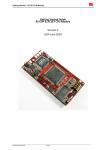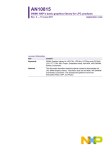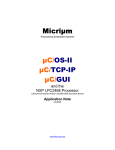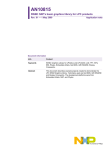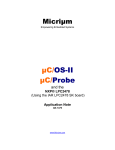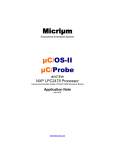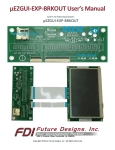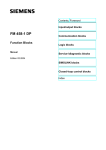Download LPC-Stick View - User Manual
Transcript
User Manual LPC-StickView V3.0 for LPC-Stick (LPC2468) LPC2478-Stick LPC3250-Stick Contents 1 What is the LPC-Stick? 2 2 System Components 2 3 Installation 3 4 Updates 3 5 Starting the LPC-Stick View Software 4 6 Operating the LPC-Stick 6 7 Start Page Buttons 23 8 Menu Commands 24 9 Troubleshooting 25 Rev. 04/2009 – 004 Windows®, Windows XP® and Windows Vista® are registered trademarks of the Microsoft corp. LPC is a registered trademark of NXP. All trademarks of other companies used in this document refer exclusively to the products of these companies. LPC-StickView User Interface 1 2 What is the LPCxxxx-Stick? LPC-Stick is an easy to use development system designed to demonstrate the ARM-core-based microcontroller features and peripheral usage like external Memory, Ethernet, CAN, USB host and USB device. The LPC-Stick features are implemented in a USB stick and controlled by an ARM-core-based microcontroller from NXP. Currently 3 stick variants are available: – LPC-Stick with an LPC2468-MCU (ARM7TDMI core) – LPC2468-Stick with an LPC2478-MCU (ARM7TDMI core) – LPC3250-Stick with an LPC2350-MCU (ARM926EJS core) When connecting one of the LPC-Sticks mentioned above to a PC's USB port, the microcontroller begins to run the default application which can be controlled with the LPC-StickView user interface. 2 System Components The following components are provided: • LPC-Stick hardware • CD ROM including HiTOP53 IDE and debugger, GNU C Compiler, Tasking Compiler (evaluation version), LPC-Stick USB drivers and LPC-StickView user interface, user documentation (electronic version) and other documents and examples. LPC-StickView User Interface 3 3 Installation Before plugging in the LPC-Stick, insert the supplied autorun CD in your CDROM drive and follow the instructions on the screen to install the software. The setup process performs the installation of the LPC-StickView software and a pre-installation of the drivers required for the USB device. In addition, the tool chain with debugger and compiler is installed. Note On Windows XP® and Windows Vista® operating systems, the driver installation has to be confirmed several times, as the drivers are not certified by Microsoft. After successful installation, the LPC-Stick can be plugged into one of your PC's USB ports. The pre-installed drivers will be selected automatically and the LPC-Stick comes up as a new device called LPC-Stick, LPC2478-Stick or LPC3250Stick depending on the stick variant used. On most Windows operating systems, the drivers for the device are found and installed automatically. If the stick is plugged into the PC for the first time, the installed driver is assigned to the stick. When the stick is powered by the USB port, the microcontroller begins to run the default application which can be controlled by the LPC-StickView user interface. Manual Driver Installation If the driver is to be installed manually, select the driver from the Driver subfolder located the installation folder. Deinstallation For deinstallation of the LPC-StickView software, select the Uninstall item from the LPC-Stick program menu. 4 Updates The LPC-Stick demo application is under continuous development. Furthermore, the supported functionality of a specific LPC-Stick depends on the firmware stored in the flash memory of the stick device. To be able using the newest features, we recommended to visit the LPC-Stick WEB page from time to time. Updates, FAQs and other information are provided there. LPC-StickView User Interface 5 Starting the LPC-Stick View Software When starting LPC-StickView by double-clicking the following desktop icon: the following window (start page) or similar is presented after the device is found: The current state is displayed in the bottom status bar of the LPC-StickView window. Normal state is "Target: LPCxxxx-Stick SerNo: nnnnn" (see figure above). The main window provides buttons for the implemented function and their controls. Tabs or menu entries which are currently not activated (either while an extension board is not connected or while a license file is missing or while the feature is not implemented in the current version) are greyed out and can not be selected. For an overview of the buttons, refer to p. 23. For an overview of the menu commands, see p. 24. 4 LPC-StickView User Interface Notes Reprogramming the Flash Memory With delivery, the demo application supporting the LPC-StickView software features is located in the Flash memory. If you modify it by using HiTOP with another application, you will first have to reprogram with the demo application as follows: 1 Close LPC-StickView if running. 2 Start HiTOP53 for LPC-Stick. 3 In the following folder (depending on your LPCxxxx-Stick used), open the project file "Demo.htp" using the Project > Open command: ..\Examples\LPCxxxx-Stick\Gnu\Demo\Demo.htp This will reprogram the Flash memory. 4 Reset the target with HiTOP and restart the application executing HiTOP's Go command and close HiTOP. 5 Restart the LPC-StickView software. Debugging the Demo Application Example with HiTOP When debugging the demo application example with HiTOP, you will have to note the following: Start the LPCStickView software and keep it running while debugging the demo application in HiTOP. If you want to exit the LPCStickView software, make sure to enable the Standalone mode before exiting: 5 LPC-StickView User Interface 6 Operating the LPC-Stick From the start page the main windows tab view is entered. Within the main window tab, different control features for the specific microcontroller and the peripherals can be selected and demonstrated. Note: Not all modules are supported by each stick variant. 6 LPC-StickView User Interface 7 IO This window page is supported by the LPC2468- and LPC2478Stick and gives a good impression on how the ports and pins of the controller can be configured. Direction, function and mode of all accessible pins can be monitored or changed. In case of connecting an extension board there are changes for fixed configurations like Ethernet or CAN functions. PWM if enabled or ADCs can be monitored: • • • • • Direction (default is input, if checked output) Function for selected pin Mode Input and Output data DAC, ADC and PWM Pinning ADC0 at Pin0.23 DAC at Pin0.26 ADC1 at Pin0.24 PWM1 to 6 at Pin2.0 to 5 ADC2 at Pin0.25 LPC-StickView User Interface 8 Power This window page is supported by the LPC2468- and LPC2478Stick and shows the current PLL configuration and the clock speed of the CPU and USB module. RTC is accessible. If no external power is connected to the Stick, the real time clock is reset with each hardware reset. This also occurs if the GUI is started. Power modes can be selected to power down the controller. Before any mode is selected, the wake up method has to be fixed. Setting the controller into power down mode disables all communication so the data can not be transmitted. To wake up the controller from power down modes always the reset or an interrupt method is provided. If the Extern IQR method is selected, the controller waits for an external signal on Pin P2.10. If no signal is applied there, the controller is not continuing operations. LPC-StickView User Interface 9 Measure This window page is supported by the LPC2468-, LPC2478- and LPC3250-Stick. Three different methods of measurement are displayed. 1. A logic analyzer function can be selected. The logic analyzer scans the selected trigger of the stick and starts sampling in a Time Base set frequency. The Buffer size limits the recording. Note that for the LPC3250-Stick this function is implemented as a software emulation, as the ADCs have no capture compare functionality. 2. For the LPC2468- and LPC2478-Stick, the ADC1 connected to the measure pin of the stick (P0.24) is scanned as well as the ADC0 (LED), the second channel connected to the green user LED (used as ambient light sensor). For the LPC3250-Stick, the ADC1 connected to the measure pin of the stick (ADIN0) is scanned as well as the ADC0, the second channel connected to ADIN1. 3. A Frequency and Event counter can be used simultaneously. This feature is not supported by the LPC3250-Stick. Note This tab is enabled when attaching the LPC-COM- and the LPC-LCD-Board. LPC-StickView User Interface 10 LPC-Stick (LPC2468): GND AGND P2.10 P0.24 (ADC1) LPC2478-Stick: A: GND B: AGND C: EINT0 pin (P2.10) D: ADC pin (P0.24) LPC-StickView User Interface LPC3250-Stick: A: ADC pin ADIN0 B: GND C: AGND D: SERVICE_N 11 LPC-StickView User Interface 12 Logic Analyzer Sniffer n Depending on the selected trigger, the logic analyzer starts waiting for a first signal. If no signals are triggered, the logic analyzer shows an empty page waiting for data. With the LPC24xx-Stick, a trigger can be one of the user pins P0.24 (Channel0) or P2.10 (Channel0). If data are sampled and the buffer is filled up, the logic analyzer starts to fill the graphic window. Using the panning and zoom enables to inspect the data in detail. Caution Do not apply overvoltage to the input pins! LPC2468-Stick: max 5.5V LPC2478-Stick: max 5.5V LPC3250-Stick: max 3.6V LPC-StickView User Interface 13 CAN This window page is supported by the LPC2468- and LPC2478Stick and shows a communication monitor for the CAN module. At a fixed transfer rate of 100 kbit/s, the user can generate single or repetitive messages driven by timer events and monitor receiving messages. The time between the messages is calculated by the CPU. Several CAN modes are implemented. The CAN module must be enabled and a mode must be selected. To generate a message, right-click into the upper field and select New message…: This will open the following dialog: LPC-StickView User Interface 14 The frame type, message ID, length and data can be filled into the message window. If a Period unequal 0 is entered, the message is sent periodically. To start the receiving monitor, right-click into the bottom field and click on Start recording: LPC-StickView User Interface 15 Memory This window page is supported by all LPCxxxx-Sticks and shows the usage of the on-board SRAM (LPC2468- and LPC2478-Stick) and SDRAM (LPC3250-Stick). If data are stored on the RAM they can be exported to the computer using the Data from RAM feature. A brief performance analysis can be started by using the Parallel Process task. If started, a process runs an MD5 checksum algorithm on the SRAM. If Memory Access is selected, generic read/write operations on the SRAM can be performed (with or without DMA). LPC-StickView User Interface 16 Ethernet This window page is supported by all LPCxxxx-Sticks and shows the current Ethernet settings of the LPC-Stick. Ethernet and Default Router Address and IP-Mask settings can be changed according to the local needs. Confirm any changes using the Change settings button. After enabling the module, a web server is started using the new settings. By clicking the Open website button, a web browser starts connecting to the web server. LPC-StickView User Interface 17 I²C This window page is supported by all LPCxxxx-Sticks and shows the I²C interface features implemented in the demo software. Depending on the selected master or slave mode, the slave settings are active or greyed out. Either by clicking the New Message button or by right-clicking into one of the display areas (Out Data/ In Data)), a dialog for generating a new message is displayed: Different addressing modes and directions are available. Note that it is possible to communicate with another LPC-Stick and other I²C supported hardware. LPC-StickView User Interface 18 UART This window page is supported by all LPCxxxx-Sticks and shows the UART communication using the extension board's UART connector. After selecting the baudrate, parity, data length and number of stop bits, the UART is initialized. Clicking on the Start recording button or right-clicking into the display area, the data from the UART are scanned and displayed. LPC-StickView User Interface 19 USB This window page is supported by all LPCxxxx-Sticks and enables the user to use USB device or USB host stack on the LPC24xx device. A USB Device configured as a Twin HID Device is implemented transmitting data to the Host PC. Connection is realized via the USB device connector on the ComBoard extension. After enabling the USB device and connecting to a PC, the data can be monitored via the Start Monitor button. LPC-StickView User Interface 20 Selecting the Twin HID Device from the Device List connects to the USB device and will start monitoring the data. USB Host (see figure on p. 19) enables a mass storage device class driver on the USB host interface of the extension board. If a memory stick is inserted to the USB host interface basic file operations are enabled using a terminal client session. To enable this start a terminal software, e.g. HyperTerminal and connect to the UART port of the ComBoard extension. Using the communication parameter - 57600 bit per Second, - 8 Data bits, - No Parity, - 1 Stop bit, and - no flow control. If the USB Host is enabled on the GUI, the USB host driver will be started. LPC-StickView User Interface After attaching a memory stick, the host driver enumerates the device and enables a command shell. The commands can be displayed by entering the string “help” in the terminal session. 21 LPC-StickView User Interface 22 SPI This window page is supported by all LPCxxxx-Sticks and shows an implementation of an SPI communication sniffer. Selecting the Clock Polarity and bit order enables the communication module. By clicking on the Start recording button, the communication is traced into the Output window. Notes • Only the MOSI or MISO communication can be sniffed at the same time. • To use the SPI sniffer, connect the SPI interface (CLK, MISO, Select, MOSI) to the SPI bus you like to monitor. With the LPC3250-Stick, the following pins are available on X701 (see Data Sheet LPC-Stick): CLK: MISO: Select: MOSI: 15 16 17 18 Connect the Select pin to GND. • Since the SPI interface of the LPC3250-Stick supports Master functionality only, the application is based on the SSP interface which is capable to work in Slave mode. LPC-StickView User Interface 7 23 Start Page Buttons IO Changes into page view and opens the IO page. Power Changes into page view and opens the Power/RTC page. Measurement Changes into page view and opens the Measurement page. CAN Changes into page view and opens the CAN page (if extension-board is connected). Memory Changes into page view and opens the Memory page (if extension-board is connected). Ethernet Setup and start Ethernet settings and WEB server. I2C Data generator and sniffer module. UART Setup comBoard UART port and sniffer. USB USB device and host control. SPI SPI sniffer. LPC-StickView User Interface 8 24 Menu Commands LPC-Stick System Reset Executing this command, the LPC-StickView applies resets to the LPC-Stick device setting it into its initial state via the reset pin. SoftReset Device Executing this command, the LPC-Stick View applies software reset of the LPC-Stick application to its initial state. Show Start Page Executing this command, the initial start page of the LPC-Stick View is shown. Exit Exiting the LPC-Stick View software. Standalone Enable Enabling standalone mode in combination with extension board. Disable Disabling standalone mode. Application Update … Updating the firmware. Help Info Displays the current version of the GUI and the firmware. User Manual LPC-Stick View user manual (this document). Schematic Schematics of – LPC-Stick (LPC2468-Stick) – LPC2478-Stick – LPC3250-Stick – LPC-comBoard – LPC-LCD-Board Visit … Links to external web page for LPC-Stick. LPC-StickView User Interface 9 25 Troubleshooting Driver Installation Possible Reason Installation process is not coming up The CD autostart feature is disabled. No driver found after plugging in the LPC-Stick device The installation process was not done. The Windows XP dialog to confirm the driver installation, was rejected by the user. Remedy • • • • Wrong installation directory. • Start the installation process by executing the setup.exe file from the CD ROM drive. Start the installation process by executing the setup.exe file from the CD ROM drive. If the installation was done successfully, the operating system asks for the according driver after plugging in the LPCStick device. In the installation directory, select the Driver subdirectory to find the required files. When prompted by the operating system, confirm to install the drivers. If the installation fails or was not done before, execute the setup.exe file from the CD ROM drive In the installation directory, select the Driver subdirectory. Software Messages Possible Reason No LPC-Stick found on COMx The LPC-Stick device is not connected to the USB port of the PC or the LPC-Stick View software was not able to detect the LPC-Stick device on the selected port. Can not find virtual serial port to communicate with the device The LPC-Stick device is not connected to the USB port of the PC or the LPC-Stick View software was not able to detect the LPC-Stick on the selected port. Can not open port … to communicate with the device or The driver was not installed properly Remedy • • • • • Check the port settings by executing the Applications > Settings command. Select another COM port and check the connection by executing the Reset Device command. Check the port settings by executing the Applications > Settings command. Select another COM port and check the connection by executing the Refresh connection command. Check if the device is connected to a functional USB port of the PC. Check if other devices on a USB port prevent the communication to the device. Check if the driver is installed, or reinstall the driver from the CD.


























